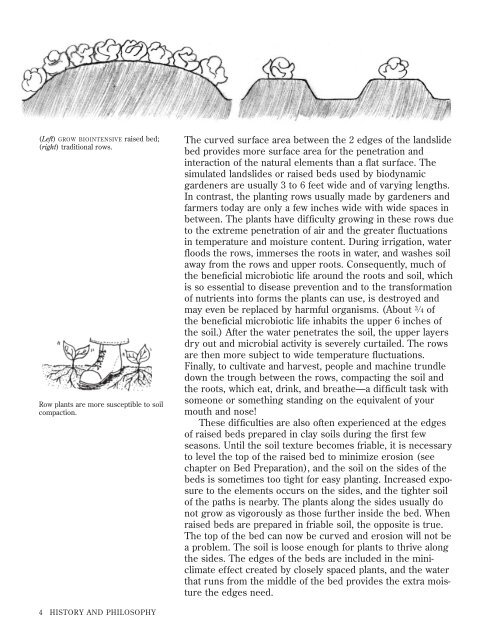How to Grow More Vegetables : And Fruits, Nuts ... - Shroomery
How to Grow More Vegetables : And Fruits, Nuts ... - Shroomery
How to Grow More Vegetables : And Fruits, Nuts ... - Shroomery
You also want an ePaper? Increase the reach of your titles
YUMPU automatically turns print PDFs into web optimized ePapers that Google loves.
(Left) GROW BIOINTENSIVE raised bed;<br />
(right) traditional rows.<br />
Row plants are more susceptible <strong>to</strong> soil<br />
compaction.<br />
4 HISTORY AND PHILOSOPHY<br />
The curved surface area between the 2 edges of the landslide<br />
bed provides more surface area for the penetration and<br />
interaction of the natural elements than a flat surface. The<br />
simulated landslides or raised beds used by biodynamic<br />
gardeners are usually 3 <strong>to</strong> 6 feet wide and of varying lengths.<br />
In contrast, the planting rows usually made by gardeners and<br />
farmers <strong>to</strong>day are only a few inches wide with wide spaces in<br />
between. The plants have difficulty growing in these rows due<br />
<strong>to</strong> the extreme penetration of air and the greater fluctuations<br />
in temperature and moisture content. During irrigation, water<br />
floods the rows, immerses the roots in water, and washes soil<br />
away from the rows and upper roots. Consequently, much of<br />
the beneficial microbiotic life around the roots and soil, which<br />
is so essential <strong>to</strong> disease prevention and <strong>to</strong> the transformation<br />
of nutrients in<strong>to</strong> forms the plants can use, is destroyed and<br />
may even be replaced by harmful organisms. (About 3 ⁄ 4 of<br />
the beneficial microbiotic life inhabits the upper 6 inches of<br />
the soil.) After the water penetrates the soil, the upper layers<br />
dry out and microbial activity is severely curtailed. The rows<br />
are then more subject <strong>to</strong> wide temperature fluctuations.<br />
Finally, <strong>to</strong> cultivate and harvest, people and machine trundle<br />
down the trough between the rows, compacting the soil and<br />
the roots, which eat, drink, and breathe—a difficult task with<br />
someone or something standing on the equivalent of your<br />
mouth and nose!<br />
These difficulties are also often experienced at the edges<br />
of raised beds prepared in clay soils during the first few<br />
seasons. Until the soil texture becomes friable, it is necessary<br />
<strong>to</strong> level the <strong>to</strong>p of the raised bed <strong>to</strong> minimize erosion (see<br />
chapter on Bed Preparation), and the soil on the sides of the<br />
beds is sometimes <strong>to</strong>o tight for easy planting. Increased exposure<br />
<strong>to</strong> the elements occurs on the sides, and the tighter soil<br />
of the paths is nearby. The plants along the sides usually do<br />
not grow as vigorously as those further inside the bed. When<br />
raised beds are prepared in friable soil, the opposite is true.<br />
The <strong>to</strong>p of the bed can now be curved and erosion will not be<br />
a problem. The soil is loose enough for plants <strong>to</strong> thrive along<br />
the sides. The edges of the beds are included in the miniclimate<br />
effect created by closely spaced plants, and the water<br />
that runs from the middle of the bed provides the extra moisture<br />
the edges need.












